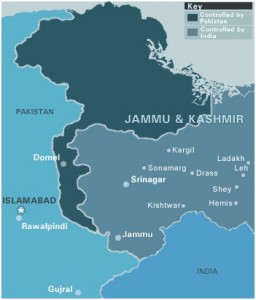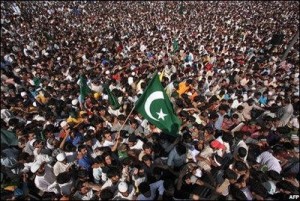World Briefing Kashmir: the occupation the world forgot
Arts & Culture, New in Ceasefire - Posted on Friday, October 8, 2010 4:43 - 9 Comments
 By Zainab Daniju
By Zainab Daniju
When searching for items on Kashmir in my local library, I get more results for a song by Led Zeppellin than for the region itself. Yet this country has been battling against oppression since 1989 – to put that into perspective, since I was 2 years old. So why now, at the age of 23, am I only beginning to learn of the struggles going on there?
Like many modern day territorial disputes, the root of the conflict in Kashmir is tied up in a colonial past that ended in 1947, with the crude British partition resulting in what we today recognise as India and Pakistan. Kashmir lies divided, not only between these two powers, but also China to the North. The region has been jostled over by its three big neighbours for over 60 years, but especially from 1987, when the people of Kashmir decided to take a more active stand in the aftermath of elections that were widely believed to have been rigged.
Today, that spirit lives on stronger than ever in the youth of Kashmir, most of whom were born after the uprisings of 1989, and described by Oxblood Ruffin, founder of Hacktivismo, as ‘generation S’ (for stone). Like their young counterparts in occupied Palestine, these stone-throwers are paying a heavy price for defending their right to self-determination. At the end of August, there was news of another civilian death, the 64th young victim since the outbreak of this summer’s continuing unrest.
Qayoum Bhat, 17, died in hospital after being released from three days in police custody. His family believe he was tortured by police, a claim that is reinforced by evidence of police brutality. On August 2 this year, a 9 year old boy was beaten to death by Indian paramilitary troops, and many locals have witnessed first-hand the brutality of the Central Reserve Police Force (CRPF).
With each new death comes fresh protests, in defiance of the curfews that have been imposed by India. These unarmed protests are met with tear gas and gunfire, resulting in further injuries and more deaths. Within a day, another youth has been critically injured after getting fired-at whilst taking part in a peaceful protest. And so the cycle continues.
The Conflict
 Put simply, the conflict in Kashmir is largely one between Pakistan and India over who has the right to govern the region. Although the majority of its inhabitants are Muslims, Kashmir’s Hindu ruler in 1947 agreed to accede to India, in return for help in defending the region against military advances by Pakistan. The conflict is thus generally presented as one between Muslims and Hindus, which may be a reason why it is so often dwarfed by the geo-strategic considerations of the India-Pakistan relationship.
Put simply, the conflict in Kashmir is largely one between Pakistan and India over who has the right to govern the region. Although the majority of its inhabitants are Muslims, Kashmir’s Hindu ruler in 1947 agreed to accede to India, in return for help in defending the region against military advances by Pakistan. The conflict is thus generally presented as one between Muslims and Hindus, which may be a reason why it is so often dwarfed by the geo-strategic considerations of the India-Pakistan relationship.
On the one hand, the Indian government blames any tensions in the area on Pakistan and on extremist groups that allegedly trying to win over the region in the battle for an Islamic state. On the other hand, Pakistan accuses India of an illegal occupation, based on flawed political agreements, with total disregard for the wishes of most Kashmiris to join Pakistan.
In reality, the truth lies somewhere in between. It is becoming increasingly harder for the Indian government to deny that the root of the current clashes in Kashmir lies in the Kashmiri people’s own grievances. This is not to deny that Pakistan has continuously tried to take advantage of this by militarising a surprisingly non-violent movement by the people of Kashmir. However, the Kashmiris are becoming increasingly fed-up with being used as pawns in this international display of egos. A recent survey showed that only 2% of the Jammu and Kashmir region not already administered by Pakistan would choose to join it, in comparison to over 40% of the region choosing a wholly independent Kashmir as the best option.
But a UN resolution in 1948 proposing a plebiscite did not give independence as an option, and today the UN, when they discuss Kashmir at all, continue to place it in a discourse of two nations: India and Pakistan.
This obtuseness is almost shocking – if anything can be, given the UN’s track record of handling ongoing disputes. The lack of an international outcry over the situation in Kashmir, however, may be less surprising when viewed alongside the unprecedented lack of international response to the recent floods in Pakistan. One online commentator seemed to put it succinctly when describing how hard they find it to “feel sympathy for the same Muslims who attack women for not covering up”.
The underlying sentiment is a common one, and not often put so honestly. The world finds it hard to feel sympathy, let alone any level of empathy, for a Muslim-majority community. Hence, many attempts at raising the issue of Kashmir are countered by arguments citing massacres of Hindu Pandits in the area.
What many people seem to miss is that both the Muslim majority, and the Hindu minority, as well as the multitude of other religious and ethnic groups in the region, are suffering as a result of the world’s refusal to take any notice of the struggles in the area.
 In a speech on India’s Independence day that left many Kashmiris disappointed, the Indian Prime Minister Manmohan Singh expressed his sympathy for their ongoing suffering. But his insistence that “India’s democracy has the generosity and flexibility to address the concerns of any groups” did not resonate with the brutal attitude of his forces in the region; and his plea that the “violence will not benefit anyone” seemed to ignore the fact that the worst of the current violence is coming from India’s own police, and their shoot-on-sight policy.
In a speech on India’s Independence day that left many Kashmiris disappointed, the Indian Prime Minister Manmohan Singh expressed his sympathy for their ongoing suffering. But his insistence that “India’s democracy has the generosity and flexibility to address the concerns of any groups” did not resonate with the brutal attitude of his forces in the region; and his plea that the “violence will not benefit anyone” seemed to ignore the fact that the worst of the current violence is coming from India’s own police, and their shoot-on-sight policy.
Given that the high point of Singh’s career was an agreement with the United States that granted India membership of the world’s exclusive nuclear power club, it is unlikely that his rhetoric will be disputed by the world superpower any time soon.
Without weapons of their own, the youth of Kashmir are using new methods to get their voices heard. I was introduced to the issue through a Facebook group asking me not to let the world forget Kashmir, by declaring “I Protest”. Their message included a link to a video of two young men clearly stating the real issues at hand on a Kashmiri news show. This video has since been removed, as each new attempt to raise the issue is quashed by Indian authorities.
Despite this, the Kashmiri youth are becoming increasingly successful at getting their voices heard, and it’s up to us to listen to them. They’re not asking to be saved – they’re simply asking for the right to live in peace. Their articulate views, which can now be found online, clearly show that they are capable of making decisions for themselves. The matter is essentially simple, but the political complications that are holding their destinies hostage, are largely nothing more than pretexts to deny them what is theirs: a basic right to self-determination.
Zainab Daniju is a writer and activist.
Ceasefire’s photo-essay ‘Kashmir: Bullets for Stones’ is available to read here.
9 Comments
Andy
yusuf
very strong piece, concise and enlightening,
Knox
A well-researched and succinctly written piece – I have learnt more from this than I have many years of ‘news’ about the situation. Thank you for presenting the situation so honestly and yet restrainedly. Please let me know where I can read any more of your articles.
Ceasefire Magazine – This week in Ceasefire
[…] Kashmir: the occupation the world forgot […]
Zainab
Thanks for the comments. I’m glad you enjoyed the piece. Carry on looking out for new articles on the Ceasefire website. If you browse the website there are lots of other in-depth articles that you’ll probabaly find interesting if you like this.
Khadija
Well written and very informative; I now have a clear insight into this issue.
Katerina
engaging and informative. thanks for the clear analysis.
undleeb
this was awesome! im glad i got both sides of the story, really informative. thank you very much.
There are still three more steps and many more guidelines on how to achieve
this very daunting task. They will not end up using the bathroom every time they go in there
but they will become familiar with the sensations associated with
using the toilet. The big swoosh of a toilet flushing can actually be very frightening to a
child.


Great article. It’s good to read a balanced article about this. The Kashmir occupation is something I’ve always known about but have never really understood. I often shy away from any political commentary due to the inevitable bias but this article leaves me informed without trying to figure out whose side I should be taking. India is a beautiful country, I can’t wait to go to the North and hopefully see what the situation is for myself.